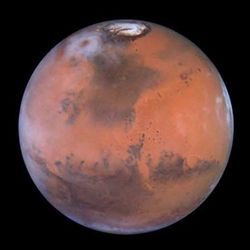Evidence Of Salt Deposits Spices Up Search Efforts
 NASA's Mars Odyssey
orbiter recently found evidence of salt deposits, pointing to
places where water once was abundant on the Red Planet... and where
evidence might exist of possible Martian life from its past.
NASA's Mars Odyssey
orbiter recently found evidence of salt deposits, pointing to
places where water once was abundant on the Red Planet... and where
evidence might exist of possible Martian life from its past.
A team led by Mikki Osterloo of the University of Hawaii,
Honolulu, found approximately 200 places on southern Mars that show
spectral characteristics consistent with chloride minerals.
Chloride is part of many types of salt, including sodium chloride
or table salt. The sites range from about a square kilometer (0.6
square mile) to 25 times that size.
"They could come from groundwater reaching the surface in low
spots," Osterloo said. "The water would evaporate and leave mineral
deposits, which build up over years. The sites are disconnected, so
they are unlikely to be the remnants of a global ocean."
Scientists used Odyssey's Thermal Emission Imaging System, a
camera designed and operated by Arizona State University, Tempe, to
take images in a range of visible light and infrared
wavelengths.
Thermal infrared wavelengths are useful for identifying
different mineral and rock types on the Martian surface. Osterloo
found the sites by looking through thousands of images processed to
reveal, in false colors, compositional differences on the Martian
surface.
Plotted on a Mars map, the chloride sites appear only in the
southern highlands, the most ancient rocks on Mars. Osterloo and
seven co-authors report the findings in this week's issue of the
journal Science.
"Many of the deposits lie in basins with channels leading into
them," said Philip Christensen, co-author and principal
investigator for the camera at Arizona State University. "This is
the kind of feature, like salt-pan deposits on Earth, that's
consistent with water flowing in over a long time."
Scientists think the salt deposits formed approximately 3.5 to
3.9 billion years ago. Several lines of evidence suggest Mars then
had intermittent periods with substantially wetter and warmer
conditions than today's dry, frigid climate.
 Scientists looking for evidence of
past life on Mars have focused mainly on a handful of places that
show evidence of clay or sulfate minerals. Clays indicate
weathering by water, and sulfates may have formed by water
evaporation. The new research, however, suggests an alternative
mineral target to explore for biological remains.
Scientists looking for evidence of
past life on Mars have focused mainly on a handful of places that
show evidence of clay or sulfate minerals. Clays indicate
weathering by water, and sulfates may have formed by water
evaporation. The new research, however, suggests an alternative
mineral target to explore for biological remains.
"By their nature, salt deposits point to a lot of water, which
potentially could remain standing in pools as it evaporates," said
Christensen. "That's crucial. For life, it's all about a habitat
that endures for some time."
Whether life ever has existed on Mars is the biggest scientific
question driving Mars research. On Earth, salt is good at
preserving organic material. Bacteria have been revived in the
laboratory after being preserved in salt deposits for millions of
years.
"This discovery demonstrates the continuing value of the Odyssey
science mission, now entering its seventh year. The more we look at
Mars, the more fascinating a place it becomes," said Jeffrey Plaut,
Odyssey project scientist at NASA's Jet Propulsion Laboratory,
Pasadena, CA.
"This is a wonderful and scientifically exciting result obtained
from a relatively low cost NASA Mars orbiter mission which still
has years of life left," said Alan Stern, associate administrator
for NASA's Science Mission Directorate in Washington. "Hold on to
your hats, more exciting results from Mars are sure to be
coming."
 Aero-News: Quote of the Day (11.17.25)
Aero-News: Quote of the Day (11.17.25) ANN's Daily Aero-Term (11.17.25): NonDirectional Beacon
ANN's Daily Aero-Term (11.17.25): NonDirectional Beacon NTSB Final Report: Fred L Wellman CH 750 Cruzer
NTSB Final Report: Fred L Wellman CH 750 Cruzer ANN's Daily Aero-Linx (11.17.25)
ANN's Daily Aero-Linx (11.17.25) Airborne-NextGen 11.11.25: Archer Buys Hawthorne, Joby Conforms, Stranded Astros
Airborne-NextGen 11.11.25: Archer Buys Hawthorne, Joby Conforms, Stranded Astros




